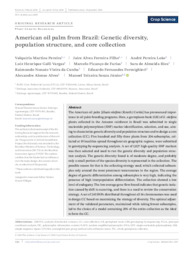American oil palm from Brazil: Genetic diversity, population structure, and core collection.
American oil palm from Brazil: Genetic diversity, population structure, and core collection.
Author(s): PEREIRA, V. M.; FERREIRA FILHO, J. A.; LEAO, A. P.; VARGAS, L. H. G.; FARIAS, M. P. de; RIOS, S. de A.; CUNHA, R. N. V. da; FORMIGHIERI, E. F.; ALVES, A. A.; SOUZA JUNIOR, M. T.
Summary: The American oil palm [Elaeis oleifera (Knuth) Cortés] has pronounced importance in oil palm breeding programs. Here, a germplasm bank (GB) of E. oleifera plants collected in the Amazon rainforest in Brazil was submitted to single nucleotide polymorphism (SNP) marker identification, selection, and use, aiming to characterize genetic diversity and population structure and to design a core collection (CC). Five hundred and fifty-three plants from 206 subsamples, collected at 19 localities spread throughout six geographic regions, were submitted to genotyping-by-sequencing analysis. A set of 1,827 high-quality SNP markers was then selected and used to run the genetic diversity and population structure analysis. The genetic diversity found is of moderate degree, and probably only a small portion of the species diversity is represented in the collection. The possible reason for that is the collecting strategy used, which collected subsamples only around the most prominent watercourses in the region. The average degree of genetic differentiation among subsamples is very high, indicating the presence of high interpopulation differentiation. The collection showed a low level of endogamy. The low average gene flow found indicates that genetic isolation caused by drift is occurring, and there is a need to review the conservation strategy. A set of 245 SNPs distributed throughout all 16 chromosomes was used to design CC based on maximizing the strategy of diversity. The optimal adjustment of the validated parameters, maintained while taking fewest subsamples, led to the choice of a model containing 20% of the entire collection as the ideal to form the CC.
Publication year: 2020
Types of publication: Journal article
Unit: Embrapa Agroenergy
Observation
Some of Embrapa's publications are published as ePub files. To read them, use or download one of the following free software options to your computer or mobile device. Android: Google Play Books; IOS: iBooks; Windows and Linux: Calibre.
Access other publications
Access the Agricultural Research Database (BDPA) to consult Embrapa's full library collection and records.
Visit Embrapa Bookstore to purchase books and other publications sold by Embrapa.

